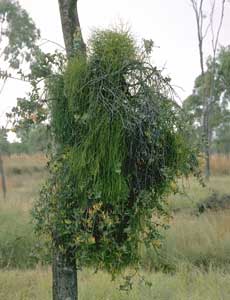Mistletoes - epiparasitism
Epiparasitism - mistletoes on mistletoes
|
Are mistletoes able to parasitize themselves or each other?
Epiparasitism is the situation in which one parasitic species is parasitized by another to which it is related. Epiparasites (or secondary parasites) are thus 'fellow travellers', perhaps advantaged by sharing some feature of their hosts (the primary parasites), such as their dispersal agents. Because the Loranthaceae and Viscaceae are relatively large families which are entirely parasitic, the common occurrence of epiparasitism in mistletoes is not surprising.
There are degrees of epiparasitism, based on the extent to which it is essential for the existence of the secondary parasite. Four categories can be recognized – autoparasitism, incidental epiparasitism, facultative epiparasitism and obligate epiparasitism.
Autoparasitism is infection by another individual of the same species. Even though their seeds may be dispersed to their own branches, it seems to be rare in mistletoes, suggesting that strong cell recognition systems are operative. Diagnosis is difficult because there is no distinct haustorial attachment – the secondary parasite seems to blend into the stem of its host.
The African Viscum fischeri is a good model to measure autoparasitism because it is dioecious (see section on evolution of dioecy), with no likelihood of sex reversal. A male branch on an otherwise female plant (or vice versa) would therefore represent autoparasitism. In a population sample of 192 only one case of epiparasitism was found, indicating a frequency of autoparasitism of less than 1%.
Incidental epiparasitism occurs when a mistletoe usually grows on tree hosts, but occasionally parasitizes another mistletoe species, with no indication of specificity or co-adaptation. It is frequently associated with widely dispersed mistletoes, and especially with “weedy” species known to infest a broad range of hosts. It is common in complex tropical and subtropical forest systems, and the host mistletoes may simply be part of the broad host range of such “weedy” mistletoes.
In Australia Dendrophthoe curvata ![]() is a good example, occurring on several tropical Amyema species as well as a broad range of tree hosts.
is a good example, occurring on several tropical Amyema species as well as a broad range of tree hosts.
Facultative epiparasitism is a situation in which a mistletoe species commonly occurs on other species of mistletoe, at least in part of its range, with some indication of co-adaptation, whilst also infesting terrestrial hosts over part or all of its range.
In some cases a mistletoe species may extend beyond the range of its preferred terrestrial host by switching its host preference to another mistletoe. A good Australian example is Amyema miraculosa ![]() , which in semiarid areas usually parasitizes Santalum, and is occasionally found on Myoporaceae and Casuarinaceae, but in the more temperate margins of its range, beyond the range of Santalum, can be found in eucalypt forests parasitic on Amyema miquelii
, which in semiarid areas usually parasitizes Santalum, and is occasionally found on Myoporaceae and Casuarinaceae, but in the more temperate margins of its range, beyond the range of Santalum, can be found in eucalypt forests parasitic on Amyema miquelii ![]() and A. pendula
and A. pendula ![]() .
.
In other cases a mistletoe may simply be one of the preferred hosts of another mistletoe over the range of the latter. An Australian example is Amyema congener ![]() , which has a wide range in eastern Australia, occurring on Allocasuarina, Acacia and Geijera spp., but also on the mistletoe Muellerina celastroides
, which has a wide range in eastern Australia, occurring on Allocasuarina, Acacia and Geijera spp., but also on the mistletoe Muellerina celastroides ![]() .
.
These cases are examples of how local populations of mistletoes appear to become genetically adapted to parasitism of local host species, such that their performance when sown on hosts some distance away is diminished. Facultative epiparasitism may be associated with genetic differentiation between populations within a particular mistletoe species.
Obligate epiparasitism is the situation in which a mistletoe species is confined to, and closely adapted to, other mistletoe species as host. Most commonly the epiparasite is a member of the Viscaceae, and host mistletoes can be either viscaceous or loranthaceous. The most common Australian example is Viscum articulatum ![]() , which parasitizes Notothixos (Viscaceae) and several genera of Loranthaceae. Occasional reports of other tree hosts may have overlooked the intermediate primary parasite, although there are a couple of confirmed host records of Exocarpos, a member of the closely related and ancestral family Santalaceae.
, which parasitizes Notothixos (Viscaceae) and several genera of Loranthaceae. Occasional reports of other tree hosts may have overlooked the intermediate primary parasite, although there are a couple of confirmed host records of Exocarpos, a member of the closely related and ancestral family Santalaceae.
The boundary between facultative and obligate epiparasitism is therefore obscure. Another borderline Australian example is Notothixos subaureus ![]() , which occurs on loranthaceous hosts over most of eastern Australia, but also occurs directly on rain forest trees in north Queensland.
, which occurs on loranthaceous hosts over most of eastern Australia, but also occurs directly on rain forest trees in north Queensland.
A striking sequence of multiple parasitism can rarely be found in eastern Australia. Obligate Viscum articulatum ![]() can be found on almost-obligate Notothixos subaureus
can be found on almost-obligate Notothixos subaureus ![]() , this in turn on facultative Amyema congener
, this in turn on facultative Amyema congener ![]() , this in turn on the primary mistletoe Muellerina celastroides
, this in turn on the primary mistletoe Muellerina celastroides ![]() , itself parasitic on Allocasuarina torulosa.
, itself parasitic on Allocasuarina torulosa.
![An Australian Government Initiative [logo]](/images/austgovt_brown_90px.gif)


